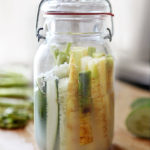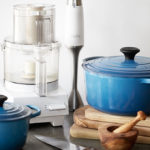
Celtic sea salt, cucumber and white carrots before a good shake. I strayed from my own rule here, so I only fermented this jar for 5 days to split the difference. The cucumber was a little mushy but still delish!
Lacto-fermented vegetables are as easy to make as tossed salad
The main difference being that you set them in a cupboard for a week or so before eating. That might seem counter intuitive in our refrigerator-centric culture, but this age old practice has fortified the immune systems of people around the world as far back as food preparation can be traced.
Lacto-fermented foods are made by allowing lactobacilli (the bacteria present in especially high numbers on produce grown close to the ground) to brake down sugars and starches into lactic-acid. This acid acts as a natural preservative by inhibiting putrefying bacteria and helps to release cancer-fighting glucosinolates, minerals and enhanced bioavailable vitamins such as C and K2 in the process.
Science has only begun to grasp the scope of the innumerable benefits
But the main premise is that by populating the gut and the body’s microbiome with probiotic microorganisms, lacto-fermented foods supply the immune-system with necessary assistance in fighting off infections, reducing inflammation and regulating metabolic processes in the body. These foods are therapeutic grade medicine for all manner of health conditions:
- Reduction in blood pressure
- Arthritis
- Asthma and allergies
- Skin problems
- Kidney problems
- Digestive issues
- Autoimmune disorders
- Anti-cancer activity–breast cancer in particular (source: PMID: 22716309)
Eat lacto-fermented foods as preventative measure
With astronomically higher efficacy rates than probiotic supplements, a couple spoonfuls of delicious, authentically fermented veggies supply the body with probiotic armies in the trillions. Because of our stomach acids and storage issues, a highly effective probiotic pill can only aim to supply you with a small fraction of the billions listed on the label.
Save money, enhance your meals and enjoy the creative process by making your own probiotic foods! This recipe couldn’t be easier!

Preparation Notes
Sauerkraut is one of my favorite lacto-fermented condiments, but if you’re not ready to spend 15 minutes squeezing out those juices, the veggie medley is an excellent first foray into probiotic food making.
Use whatever veggies you like best! Create a medley using either hard veggies such as radishes, green beans, daikon, carrots, etc.; or soft veggies like cauliflower, broccoli, cucumber and summer squash.
A good starter batch is a simple combination of green beans with garlic–which require almost no prep. Beets alone will yield a beautiful red elixir called beet kvass. Once you have your ingredients, prep time will require only about 10 minutes, leaving plenty of room to be creative.
Tips to keep in mind
- Use filtered water to rinse your veggies. Any residual chlorine, chloramine, fluoride or other common tap water contaminants may inhibit the bacteria from doing their job.
- Use organic ingredients, to avoid polluting and inhibiting the enzymatic process, while also increasing the mineral content of your final product. (On the flip side, if you can’t get organic veggies, the fermentation process has been known to reduce pesticides.)
- Cut veggies into uniform strips. Discard any ugly tips if you like.
- Pair soft vegetables like cucumber or cauliflower with other like veggies, and hard roots such as carrots with their own kind for consistent texture.
- If you’re working with a soft vegetable like cucumber or cauliflower, ferment for no more than 4 days. Have a taste at 3 days. If the veggies are fizzy and have a crisp texture, you’re done.
- Try using a cleaned, boiled stone to keep your veggies below the water. Whatever is not submerged below the liquid will not ferment and may turn brown.
- If you’re ready to invest in a no fuss lid complete with a spring to keep the veggies in place, try Kraut Source’s stainless steel fermentation lid.
- Skim and toss any brownish grime floating at the top of the jar when finished fermenting.
- Once you’ve gobbled up all those deliscious veggies, reserve a 1/2 cup of the remaining probiotic brine for your next batch and drink the rest!

Ready to ferment! These string beans were giving me grief floating up. I had no cabbage leaf, so I used a few chopped chard stems to push them down below the liquid.
Making your own whey
If you’re not familiar with liquid whey, it has little to do with the processed, denatured protein powders sold in health food stores. Liquid whey is a health promoting tonic full of minerals, amino acids, vitamins and probiotics that help to fortify fermented foods.
Aside from veggies, whey can be used to make lacto-fermented sodas, such as ginger-ale, or simply added to smoothies or when cooking foods such as grains or soups. Follow these simple steps:
- Get a straining bag. I prefer this organic cotton variety.
- Using a plain organic kefir, pour it into the bag and hang over a large ceramic or glass bowl.
- You can use yogurt, but it will yield less whey.
- Feel free to squeeze some of the liquid through, but don’t put too much pressure on the bag. This is how they end up with tears and holes!
- Let the bag drip for several hours. Don’t worry–the whey, nor the curds will go bad.
- Transfer the whey to a glass jar and refrigerate. It’ll be good for months.
- Enjoy the curds as you would cottage cheese.

Skimmed and ready to eat! Fermented at approximately 75F for 10 days. Crisp and full of flavor, plus the brine is just divine. Fizzy and tart. Better than any soda-pop money can buy!

Here they are freshly opened with the bit of grime and extra stems that needed to be removed.




